How to Make Compost for Your Vegetable Garden
This post may contain affiliate links, which means that I may receive a commission if you make a purchase using these links. As an Amazon Associate I earn from qualifying purchases.
If you are looking to grow a lush and fruitful vegetable garden, composting is one of the best things you can do for your plants. Learn how to make compost for your vegetable garden with our easy-to-follow guide.
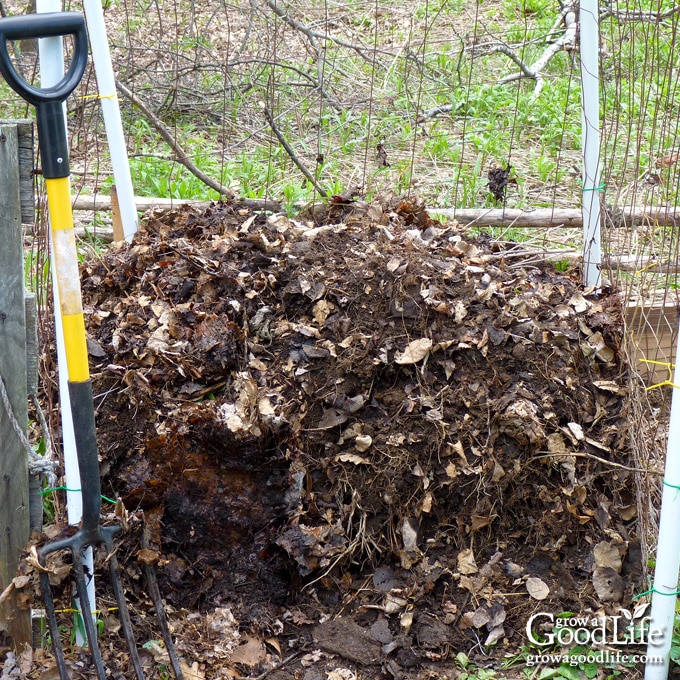
Okay, let’s get real for a second. If you are a backyard gardener and you’re not composting, you’re missing out on some seriously awesome benefits. Composting is basically like making your own plant superfood, and your veggie garden will thank you for it.
By far, compost is the best source of organic matter to improve and nourish your garden soil. While you can purchase finished compost in bulk from your garden center, the best compost for your garden is one that you make yourself. I can’t tell you the number of times I purchased bags of compost and found large pieces of wood, screws, and even bits of plastic or other non-compostable materials. When you make your own, you’ll know exactly what goes into it.
Composting is actually quite easy, and it’s important to remember that it’s a natural process that occurs with or without our intervention. You don’t have to worry about getting everything just right or having the perfect compost pile. Even if you’re not able to tend to your pile regularly, it will still break down over time and eventually become usable compost. So don’t be intimidated by the idea of composting – it’s an easy process that anyone can do!
But getting started with composting can be overwhelming. With so many different types of composting and methods for building and maintaining a compost pile, it’s hard to know where to begin.
In this article, we’ll guide you through the process of making compost for your vegetable garden, from understanding how composting works to choosing a location for your compost pile, troubleshooting common problems, and using your finished compost in your garden. So grab a shovel, and let’s get started!
What is Compost?
Compost is a dark, crumbly, and nutrient-rich soil amendment that is made by breaking down organic materials such as food scraps, yard waste, and other plant-based materials.
It is a natural process that happens when microorganisms such as bacteria, fungi, and earthworms break down the organic material, converting it into a rich soil-like substance that can be used to nourish plants. The process requires four main ingredients: browns, greens, water, and air.
- Browns are carbon-rich materials, such as dried leaves, wood chips, or newspaper. They provide the food that the microorganisms consume as they break down the material into compost.
- Greens are nitrogen-rich materials like grass clippings, kitchen scraps, or manure. They heat up the pile and create the ideal conditions for the materials to break down.
- Water is important to keep the materials moist and help the microbes do their work. A good rule of thumb is to keep the compost pile damp. If the pile is too dry, it will slow down the composting process. If it is too wet, it can become anaerobic and start to smell.
- Air is also essential for the bacteria that do the work of breaking down the organic matter. Without oxygen, the pile can become compacted and rot rather than compost. Regularly turning the pile provides air to the microorganisms and keep the process going.
Compost is a natural result of combining and breaking down these components into a nutrient-rich soil amendment.
Why Composting is Beneficial for Your Garden
So, while we understand that composting is awesome for your veggie garden, let’s dive deeper into the benefits. Here are just a few reasons why you should start composting at home:
- Nutrient-rich soil: Compost is a natural fertilizer rich in essential nutrients. When you add compost to your garden soil, you give your plants nutrients like nitrogen, phosphorus, and potassium, which they need to grow big and strong.
- Improved soil structure: Compost also helps to improve soil structure, which is important for healthy plant growth. Adding compost to your soil helps improve drainage, aeration, and water retention, making it easier for plant roots to grow and absorb nutrients.
- Reduced waste: Composting is a great way to reduce waste. Instead of throwing your food scraps and yard waste into the trash, you can turn them into a valuable soil amendment that will benefit your garden. By composting, you’re diverting waste from landfills and reducing greenhouse gas emissions.
- Cost-effective: Composting is a cost-effective way to improve your garden soil. Instead of buying expensive fertilizers and soil amendments, you can make your own compost using free materials like food scraps, yard waste, and fallen leaves.
Overall, composting is a win-win for your veggie garden. By composting at home, you can reap all these benefits and help reduce food waste while contributing to a healthier environment. In addition, it’s easy to do.
Of course, there are many different methods and techniques you can use, depending on your space, materials, and personal preferences. But don’t worry, we’ll cover some of those in the next section.
Methods of Composting
There are several different types of composting methods, each with its own benefits and drawbacks. Here’s a quick rundown of some of the most common types of composting:
Hot Composting
Hot composting is a method that requires more management and can produce compost faster by generating heat through the activity of microorganisms in the compost pile. It involves actively managing your compost pile to speed up the decomposition process.
To begin hot composting, you’ll need to create a pile that’s at least 3 feet tall and 3 feet wide, containing a layered mix of brown and green materials. Then adapt the moisture as needed to provide an optimal environment for the microorganisms to thrive. Additionally, you’ll need to regularly turn the pile to aerate and monitor its temperature to ensure it stays between 130 to 140˚F.
Hot composting is the fastest way to produce compost because the high temperature accelerates the decomposition process. The heat also helps to kill weed seeds and pathogens that may be present in the compost, making it safer to use in your garden.
Cold Composting
Cold composting, also known as passive composting, is a slower process that only needs a little of your attention. Cold composting involves adding organic material to a compost bin or pile and letting it break down naturally over time. Unlike hot composting, turning it on a frequent schedule or monitoring the temperature is unnecessary.
However, you should occasionally monitor the pile to check the temperature and moisture level and turn it to provide air to the microorganisms. The process can take anywhere from 6 months to a year or more, depending on the materials used and the climate.
Cold composting takes longer to produce compost than hot composting, but it requires less effort and attention. It is a good option for gardeners who don’t generate a lot of organic waste or who are not in a hurry to produce compost.
Vermicomposting
Vermicomposting, also called worm composting, is a method that uses worms to break down organic materials into compost. You’ll need a worm bin and red wiggler worms to do this. You’ll then add your food scraps and other organic materials to the bin and let the worms do their thing. Vermicomposting can produce compost in as little as a few months and is a great option for apartment dwellers or those with limited space.
Trench Composting
Trench composting is a method that involves digging a trench in your garden bed, filling it with organic materials, and then covering it with soil. As the materials decompose, they release nutrients into the ground, which can help to fertilize your plants. Trench composting can take anywhere from a few months to a year or more, depending on the materials used.
Sheet Composting
Sheet composting, also known as lasagna gardening, is a method that involves layering organic materials directly onto your garden bed. To do this, you’ll start by creating a layer of brown materials, followed by a layer of green materials, and then a layer of soil. After that, you’ll continue layering until you’ve created a compost “lasagna” that’s several inches thick. Sheet composting can take anywhere from a few months to a year or more to produce compost.
Each of these composting methods has its own advantages and disadvantages, so it’s important to choose the one that works best for you and your garden. Experiment with different ways and see what works best for your space, materials, and lifestyle.
How to Compost at Home
Now that you know the benefits of composting and the different methods, it’s time to start with your own compost pile. Here are the steps to setting up your first compost pile:
Step 1: Choose the Right Location
When choosing a location for your compost pile, look for a spot that’s convenient to access both from your kitchen and garden but also out of the way enough that it won’t be an eyesore. You’ll also want to make sure that the location has good drainage and is protected from excessive sunlight and wind.
Step 2: Set Up Your Container
While you don’t necessarily need a container to compost, it can help to keep your pile enclosed and organized. You are aiming for an area that is about 3 x 3 feet. Some container options include a simple pile, a compost bin, or a tumbler.
My compost bin is made out of recycled pallets, fencing, and poles. It is divided into three sections, one for gathering material, one for actively composting, and one to store finished compost ready for use.
Consider the amount of space you have and the amount of compost you want to produce when choosing your container.
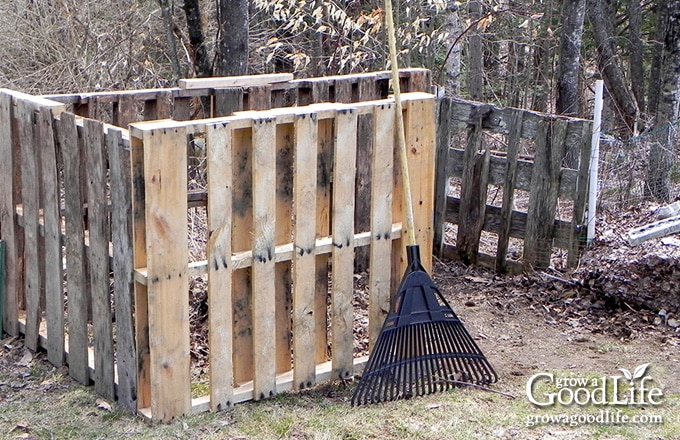
Step 3: Gather the Materials
Collect a mix of brown and green materials. Brown materials include things like leaves, straw, and shredded paper, while green materials include things like food scraps, grass clippings, and coffee grounds. You’ll also want to add some soil, finished compost, or compost starter to help kick-start the decomposition process. Aim for a mix of 2 parts brown to 1 part green.
Here’s a list of suggested compostable items:
Carbon Sources (Browns):
- Dry leaves
- Straw
- Shrub trimmings
- Small twigs
- Sawdust
- Pine needles
- Wood chips
- Corncobs and cornstalks
- Newspaper (shredded, uncoated)
- Cardboard (shredded)
- Eggshells (crushed)
Nitrogen Sources (Greens):
- Fruit and vegetable peels and scraps
- Grass clippings (untreated)
- Spent garden plants (not diseased)
- Coffee grounds and filters
- Tea bags
- Weeds that haven’t gone to seed
- Seaweed
- Manure (cow, horse, poultry, sheep, rabbit)
- Alfalfa or other terminated cover crops
Items not to compost:
- Meat and dairy products
- Bones
- Fats and oils
- Pet feces
- Synthetic fabrics
- Plastic
- Diseased plant material
- Weeds with seeds
- Charcoal ash
- Colored paper or glossy paper
- Plants treated with herbicides or pesticides
Step 4: Layer the Pile
Start by creating a layer of brown materials such as wood chips, dry leaves, straw, or shredded newspaper, followed by a layer of green materials like kitchen scraps and fresh grass clippings.
Add a few shovelfuls of soil or finished compost with each layer to supply established organisms. Water each layer as you build it so the material is moist, not soaking wet. Repeat this layering process until the pile is at least 3 feet tall.
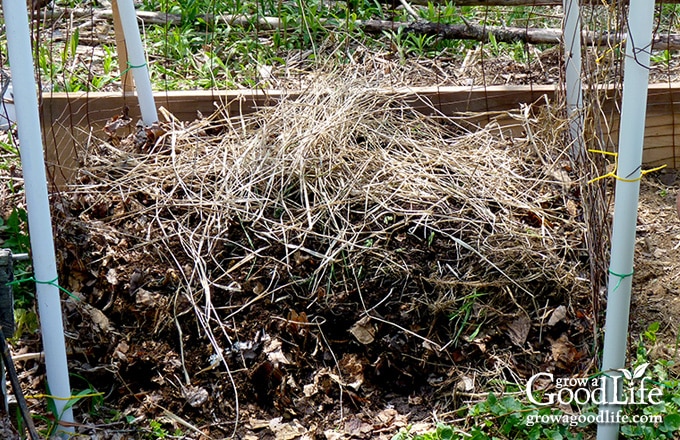
Step 5: Maintain Your Compost Pile
Composting is an ongoing process requiring occasional maintenance to ensure your compost breaks down effectively. Here are some tips for maintaining your compost heap:
- Turn and aerate the pile: Oxygen is required to support the growth of beneficial organisms that breaks down the organic material. After the pile has been assembled, turn it every week or two to introduce oxygen to the microorganisms and ensure even decomposition. If you have a compost tumbler, simply rotate it. If not, use a garden fork or shovel to turn the pile. This will help to aerate the pile and distribute air throughout.
- Watch the temperature: The temperature of your pile will begin to rise as the materials start to decompose. Use a compost thermometer to monitor the temperature of your pile regularly. A hot compost pile should reach temperatures of at least 130 to 140˚F to effectively breakdown materials and kill pathogens and weed seeds. However, if the compost gets above 160˚F, it can kill off the beneficial microbes and lead to anaerobic conditions. Use a pitchfork or shovel to turn the pile more frequently to help distribute the heat.
- Monitor moisture: Keep your compost pile moist but not too wet. If your pile is too dry, activity in the pile will slow or cease. If the compost is too wet, it will limit the amount of oxygen available to the microorganisms responsible for breaking down the organic materials, slowing down or stopping the composting process altogether. Use a hose or watering can to add water if it’s too dry, and add more dry brown materials if it’s too wet.
- Add new materials: As you accumulate new brown and green materials, continue to add them to your compost pile. Aim for a mix of roughly 2:1 brown to green materials to ensure your compost stays balanced.
- Wait for finished compost: Over time, the materials in your compost pile will break down into a dark, crumbly soil amendment. The time it takes will depend on the materials used, the composting method, and other factors like temperature and moisture.
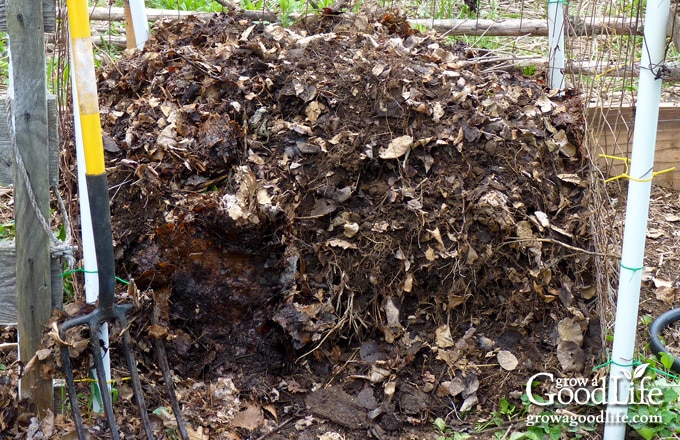
Once your compost is ready, it’s time to use it in your veggie garden! Spread a layer of compost over your garden soil, and mix it in well. Your plants will thank you for the nutrient-rich boost.
Troubleshooting Common Composting Problems
While composting is a straightforward process, a few common issues can arise. Here’s what you need to know to troubleshoot them:
- Odors: If your compost pile smells foul, it’s likely too wet and not getting enough oxygen. To fix this problem, turn the pile and add dry, brown materials like leaves or shredded newspaper to absorb excess moisture. If the odor persists, you may need to repeat the process, turning and adding more brown materials to balance.
- Pests and rodents: Composting can attract pests and rodents like flies, ants, and rats. To discourage these critters, avoid adding meat, dairy, or oily foods to your compost pile, and bury any food scraps deep in the pile. You can also line your container with a wire mesh or hardware cloth layer to prevent rodents from burrowing in.
- Slow or stalled composting: If your compost pile isn’t breaking down as quickly as you’d like, it may be because the pile is too small, too dry, or lacking in nitrogen-rich “green” materials. To speed up the process, try adding more green materials like grass clippings or vegetable scraps, or increase the size of your pile to help generate more heat. Also, make sure to give it a stir to provide oxygen throughout all parts of the pile to help feed the beneficial microorganisms that break down the material.
By understanding and addressing these common composting problems, you can keep your compost pile healthy and thriving and produce nutrient-rich compost for your vegetable garden.
What is Finished Compost?
When we talk about feeding garden soil, you will often hear the term “finished compost,” as in, “Work two inches of finished compost into the top layer of the soil.” How can you tell when the compost is finished?
Depending on your composting method, your compost may take anywhere from a few months to a year to break down fully.
Compost is ready to use when it has broken down into a rich, loamy dark brown humus with a pleasant, earthy smell. Some materials, such as sticks, thick stalks, or large pieces of eggshells, may not compost as quickly as other materials, but as long as the majority of the compost looks like soil, it is ready to use. You can sift the large chucks out using 1/4-inch hardware cloth. I tend to pile it on the garden beds as is and cover it with mulch. It will break down naturally over time.
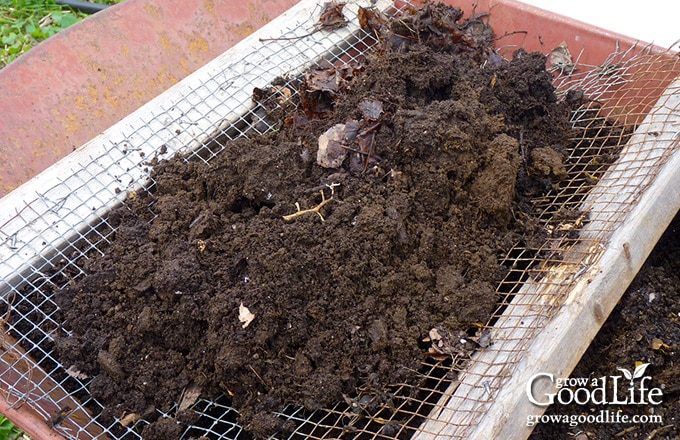
Using Compost in Your Vegetable Garden
Once your compost has broken down into a dark, crumbly material, it’s time to use it in your vegetable garden.
To harvest your compost, use a pitchfork or shovel to remove the finished material from the bottom of the pile. As you remove the finished compost, set aside any larger pieces that haven’t broken down fully and return them to the pile.
Mix your finished compost into the soil in your vegetable garden. Aim for a 2 to 3-inch layer of compost on top of your soil and work it in using a garden fork or hoe. Here are some additional ways you can use your finished compost:
- Garden prep: Before planting new vegetables, flowers, or herbs in your garden, you can spread a layer of finished compost over the soil. Mix the compost into the top 6 to 8 inches of soil using a garden fork or hoe. This will add nutrients and improve soil structure, which will help your plants grow healthier and stronger.
- Mulch: You can also use compost as a mulch around your plants. Spread a 2 to 3-inch layer of compost over the soil and around the base of your plants, taking care not to cover the stems or leaves. The mulch will help retain moisture, suppress weed growth, and provide a slow-release source of nutrients for your plants.
- Compost tea: Compost can be steeped in water to create a nutrient-rich liquid fertilizer that can be used to water plants or sprayed onto foliage.
- Side dress: To provide an extra boost of nutrients to your plants mid-season, you can side-dress them with finished compost. Simply sprinkle a small amount of compost around the base of the plant, taking care not to cover the stems or leaves. Then, use a garden fork or hoe to work the compost into the top inch of soil. This will help feed your plants and promote healthy growth.
- Container plants: If you have potted plants, you can mix finished compost into the potting soil to provide a slow-release source of nutrients. Use a 1:1 ratio of compost to potting soil and mix thoroughly before planting. You can also top-dress your potted plants with a layer of finished compost to help retain moisture and provide nutrients.
- Houseplants: Mix compost with potting soil for your houseplants to provide nutrients and improve soil structure.
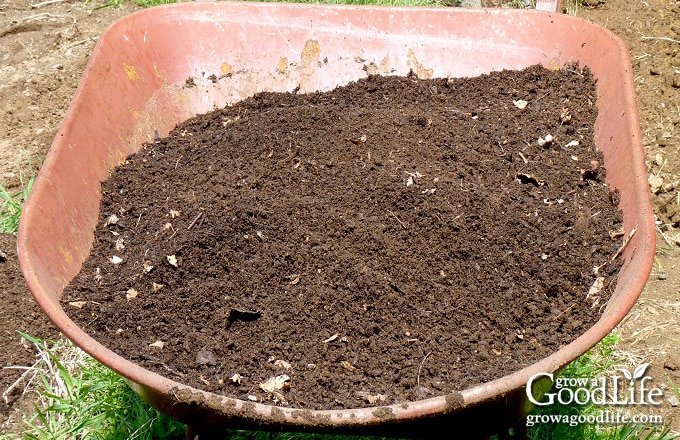
Remember, using compost is a natural and sustainable way to improve the health of your garden. And the best part is that you can make your own compost at home using kitchen scraps, yard waste, and other organic materials.
Ready, Set, Compost! A Recap of How to Make Nutrient-Rich Soil
Composting is a simple way to create nutrient-rich soil for your vegetable garden while reducing waste and supporting a healthy ecosystem. By following the tips and techniques outlined in this article, you can start your own compost pile at home and watch your garden thrive.
To recap, we covered the importance of composting for your vegetable garden, the different methods of composting, how to build and maintain your compost pile, using your finished compost, and how to troubleshoot common composting problems.
We encourage you to take the first step towards composting and experiment with building your own compost pile. It may take some time and effort, but the results will be well worth it. Not only will you be doing your part for the environment, but you’ll also be producing nutrient-rich compost to help your vegetable garden grow and flourish.
Remember, composting is a natural process that happens with or without our help. So don’t stress too much about getting everything exactly right or having the perfect compost pile. Even if you don’t tend to your compost pile regularly, it will still break down over time and eventually turn into usable compost.
The key is to get started and experiment with what works best for you and your garden. Over time, you’ll learn what materials to add, how often to turn your pile, and how to maintain the right balance of moisture and temperature. Don’t be afraid to make mistakes or try new things – composting is all about trial and error!
So don’t let the fear of doing it wrong hold you back from starting your own compost pile. Instead, embrace the process and enjoy the rewards of creating nutrient-rich soil for your vegetable garden while reducing waste and supporting a healthy ecosystem.
—
Creating a thriving garden ecosystem is key to growing a healthy and flavorful vegetable garden. Cover crops, green manures, compost, and mulch are among the most effective ways to build and nourish your soil naturally without resorting to synthetic fertilizers and pesticides.
Combining these techniques can help you create a healthy and fertile environment for your backyard vegetable garden. Check out our 7 Simple Techniques to Improve Garden Soil article to learn more about improving your garden soil.
Happy Gardening!
Good planning is key to a successful vegetable garden
Whether you are new to growing your own food or have been growing a vegetable garden for years, you will benefit from some planning each year. You will find everything you need to organize and plan your vegetable garden in my PDF eBook, Grow a Good Life Guide to Planning Your Vegetable Garden.

